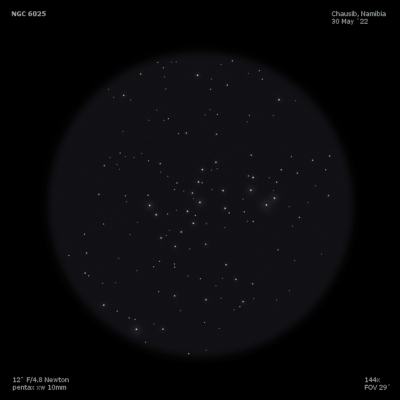
The cluster straddles TrA and Norma and was just visible naked-eye. Abell 3627 (the core of the "Great Attractor"!) lies 1.5 degrees southeast and deep images show a number of very faint galaxies within and around the borders of the cluster that are probably outlying members.
Nicolas-Louis de Lacaille discovered NGC 6025 = Lac III 10 = D 304 = h1941 in 1751-1752 using a 1/2" telescope at 8x during his expedition to the Cape of Good Hope. With this small telescope he noted "three faint stars in line in nebulosity." Dunlop observed the cluster 5 times with his 9-inch reflector from Parramatta and recorded "(Lambda Circini) Lacaille describes this as three small stars in a line with nebula. No particular nebula exists in this place. A group of about twenty stars of mixt magnitudes, forming an irregular figure, about 5' or 6' long, answer to the place of the Lambda. This is in the milky way; and there is no nebula in the group of stars except what is common in the neighbourhood."
John Herschel lists 4 observations in the Cape Catalogue: on his first sweep (22 Apr 1835) he logged "VII.; loose; scattered; brilliant; stars large; much more than fills field; 46 stars counted above 12th mag; chief star 7th mag taken." On a second sweep as ""Chief star 7th mag of a large, oblong, bright scattered cluster, stars 7..10th mag."
400/500mm - 18" (7/7/02 - Magellan Observatory, Australia): at 76x using a 27mm Panoptic, this cluster was a very pretty sight. It appeared loose but bright and large, ~13' diameter, with 50-60 stars resolved. A couple of dozen stars are mag 11.5 or brighter and seem to form a continuous loop or exaggerated "S" shape with no central concentration! At 128x, ~80 stars were visible but the cluster was really too large for a good view at this power. Two brighter mag 7 and 8 stars are at the SE end (HD 143448, the northern one, is the brightest in the cluster and a Be type) with mag 8.5 and 9 stars near the NW edge.
Notes by Steve Gottlieb